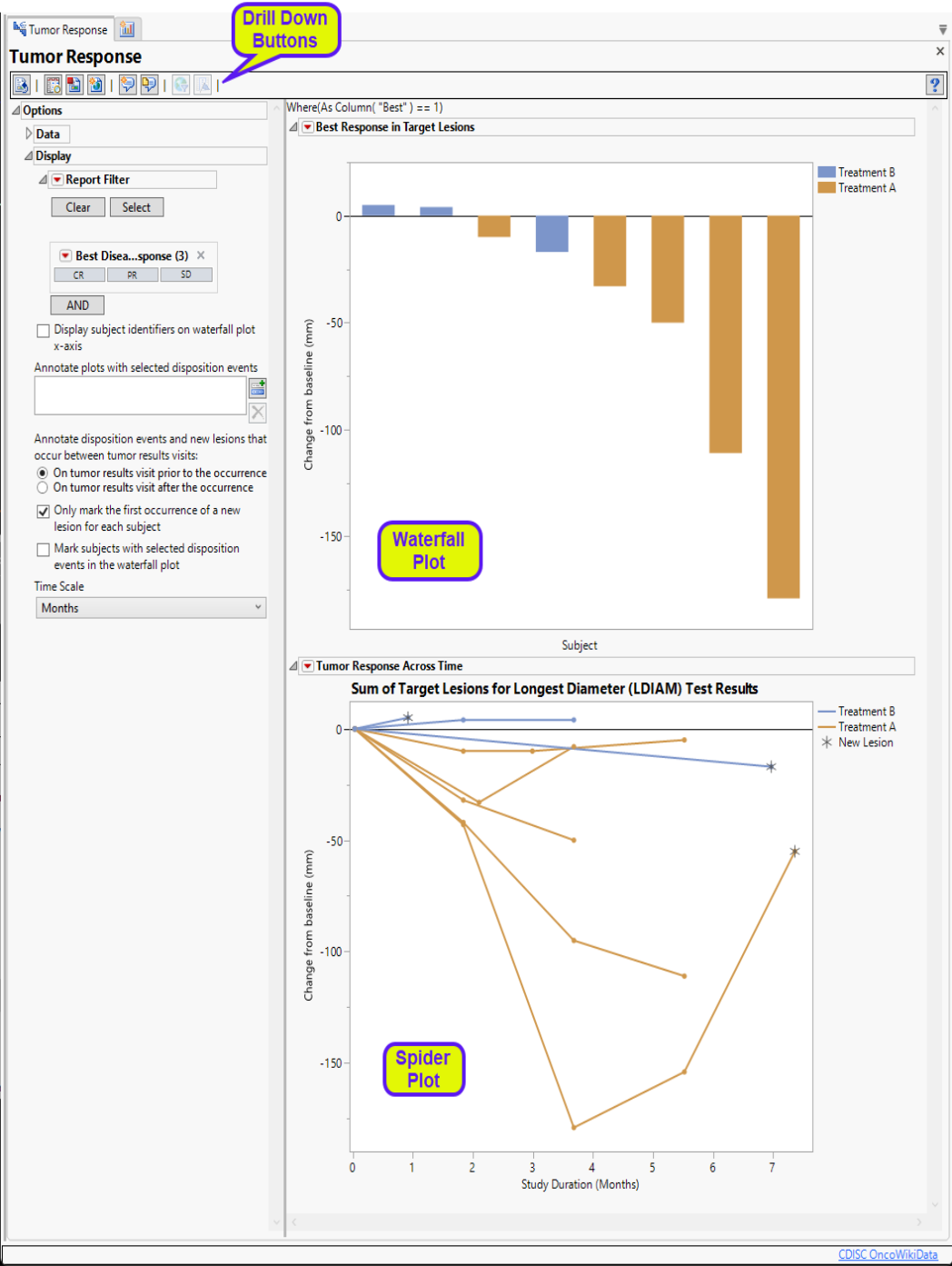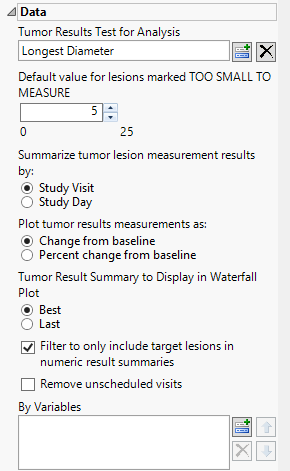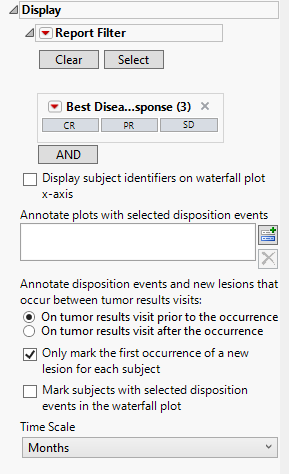Tumor Response
This process uses the TR, TU (optional), and RS (optional) oncology domains to create spider plots showing tumor results and waterfall plots showing Best or Last recorded responses. Spider plots may be annotated with new lesions or selected disposition events. Measurements plotted on the spider plot and summarized in the waterfall plot represent change or percent change of tumor burden from baseline in measurable/target lesions. For direct lesion measurement tests such as LDIAM or DIAMETER, lesions are summed and compared to the baseline lesion summation by study visit or study day. If a derived summary test such as the sum of diameters or percent change from baseline is run, then the report will plot the recorded values across time for subjects with recorded measurements.
Report Results Description
Running this report for a modified Nicardipine study using default settings generates the report shown below.

It contains the following elements:
| • | One Waterfall Plot |
This plot shows the “best” percent change in overall tumor burden1 relative to the baseline for each subject that occurred during the study period. Bars above Baseline2 represent overall tumor growth, bars below baseline represent overall tumor shrinkage. Bar color corresponds to treatment. Subjects who show no change in tumor size are represented by a + symbol on the plots instead of a bar.
| • | One Spider Plot |
This Overlay Plot shows the percent change in tumor size relative to the baseline for each subject at each visit over the course of the study. The appearance of a new lesion is indicated by an asterisk ( ).
).
Note: Dotted lines are drawn on each plot to indicate minimal changes in summed target lesions required for partial response (-30%) or progressive disease (+20%).
| • | One Report Filter. |
This enables you to subset subjects based on their best disease response and whether or not new lesions were detected. Refer to Data Filter for more information on specifying additional filtering criteria.
Note: When the study includes multiple evaluators (as specified in TREVAL), the report generates a separate waterfall plot and spider plot for each evaluator. Each plot displays only those subjects assessed by the evaluator. If there is a case where a subject is assessed by multiple evaluators, the responses from all evaluators are shown, so long as there are not multiple IDs (TREVALID). In this case only the responses collected by the evaluator flagged in TRACPTFL.
Options
Data

Tumor Results Test for Analysis
Use Tumor Results Test for Analysis widget to select the test to be used both for creating the summary measurement value to plot by time in the spider plot and to summarize in the waterfall plot where each subject is represented with a bar whose height is determined by the calculated Best or Last value.
Default value for lesions marked TOO SMALL TO MEASURE
Use the Default value for lesions marked TOO SMALL TO MEASURE widget to specify a value to replace when TRSTRESN is missing and the TRSTRESC result has a value of TOO SMALL TO MEASURE. Per RECIST guidelines, this should be a value of 5mm.
Summarize tumor lesion measurement results by:
Use the Summarize tumor lesion measurement results by: widget to select either Study Visit or Study Day as the time period to summarize the results by. Selecting Study Visit uses VISIT/VISITNUM and potentially Time Point (TRTPT if detected) for defining groups of lesions that should be aggregated to create a measurement for tumor burden. Alternatively, selecting Study Day sums lesions based on the date of the test (transformed into days relative to study start. Note: This option is still used to define unique measurements by visit/day and will average measurements if there are multiple results on the same visit/day if the test selected or chosen is an already summed representation of tumor lesion burden.
Plot tumor results measurements as:
Use the Plot tumor results measurements as: widget to select the type of findings measurement values to plot. Selecting Change from baseline plots the change from the findings baseline measurements (determined by the xxBLFL variable or by Study Day less than 1). Selecting Percent Change from Baseline plots the percent change from the findings baseline measurements. Percent Change from Baseline is specified by default.
Tumor Result Summary to Display in Waterfall Plot
Use the Tumor Result Summary to Display in Waterfall Plot widget to select the statistic by which to summarize the data from the trial period. (The mean is always used to summarize data from the baseline period.) Best refers to best overall response. Last refers to the last observed value.
Filter to only include target lesions in numeric result summaries
When the Filter to only include Target Lesions in numeric result summaries widget is checked, the report algorithm attempts to find target lesion information based on values in the following SDTM identifying variables (in order of preference for detection): TRGRPID, TRCAT, TUSTRESC or TUORRES (via unique TRLNKID to TULNKID). If the values of the determined variable contains TARGET and does not contain values such as NEW, NON-TARGET, or NOT TARGET, then these records are only used for evaluating tumor result measurements for plots. When this option is unchecked, any record for the selected or determined TRTEST for analysis that has a numeric result (TRSTRESN) is included in the calculation and summary plots.
Remove unscheduled visits
Unscheduled visits can occur for a variety of reasons. By default, these are excluded from this analysis. However, by unchecking the Remove unscheduled visits box, you have the option of including them.
By Variables
You can subdivide the subjects and run analyses for distinct groups by specifying one or more By Variables.
Display

Report Filter
Filters enable you to restrict the analysis to a specific subset of subjects and/or tumor results data, based on values within variables. You can also filter based on population flags within the study data. Refer to Data Filter for more information.
Display Subject identifiers on waterfall plot x-axis
By default, subject identifiers are not included on the waterfall plots. Click the Display subject identifiers on waterfall plot x-axis box to display the subject identifiers on the x-axes of the plots.
Annotate plots with selected disposition events
The Annotate Plots with Selected Disposition Events option enables you to annotate the output plots with selected disposition events. This feature enables you to quickly identify subjects experiencing those events and when during the study the event occurred.
Annotate disposition events and new lesions that occur between tumor results visits
Use the Annotate disposition events and new lesions that occur between tumor results visits: option to annotate visits (in the spider (line trend) plot) before or after the occurrence of a new lesion or disposition event when the study day (determined by TRDTC or DSDTC for new lesions or disposition events respectively) is between tumor lesion summary measurement results.
Only mark the first occurrence of a new lesion for each subject
Use the Only mark the first occurrence of a new lesion for each subject to annotate the first occurrence of any new lesion only per subject in the spider (line trend) plot. New lesions are marked with an asterisk at the visit where it occurred or anchored to a visit value based on the comparison of study day and the preference set on the report options to annotate either prior/after the occurrence if the new lesion detection falls between valid measured tumor lesion summary days. This option is checked by default. If unchecked, all records with a valid date and whose tumor identification contains NEW are marked.
Mark subjects with selected disposition events in the waterfall plot
By default, the report marks only the occurrence of disposition events for a given subject on the spider/trend plot. If the Mark subjects with selected disposition events in the waterfall plot option is checked, then a black point marker is also used just above the best/last summary response value for a given subject in the waterfall plot provided the subject has any of the selected disposition events recorded.
Time Scale
By default, time is measured in months. However, you can change the Time Scale to plot time in either months or weeks. This option is useful for assessing report graphics for exceptionally long studies.
General and Drill Down Buttons
Action buttons, provide you with an easy way to drill down into your data. The following action buttons are generated by this report:
| • | Click  to rerun the report using default settings. to rerun the report using default settings. |
| • | Click  to view the associated data tables. Refer to Show Tables/View Data for more information. to view the associated data tables. Refer to Show Tables/View Data for more information. |
| • | Click  to generate a standardized pdf- or rtf-formatted report containing the plots and charts of selected sections. to generate a standardized pdf- or rtf-formatted report containing the plots and charts of selected sections. |
| • | Click  to generate a JMP Live report. Refer to Create Live Report for more information. to generate a JMP Live report. Refer to Create Live Report for more information. |
| • | Click  to take notes, and store them in a central location. Refer to Add Notes for more information. to take notes, and store them in a central location. Refer to Add Notes for more information. |
| • | Click  to read user-generated notes. Refer to View Notes for more information. to read user-generated notes. Refer to View Notes for more information. |
| • | Click  to open and view the Review Subject Filter. to open and view the Review Subject Filter. |
| • | Click  to specify Derived Population Flags that enable you to divide the subject population into two distinct groups based on whether they meet very specific criteria. to specify Derived Population Flags that enable you to divide the subject population into two distinct groups based on whether they meet very specific criteria. |
Default Settings
Refer to Set Study Preferences for default Subject Level settings.
Methodology
**Need Verbiage here.